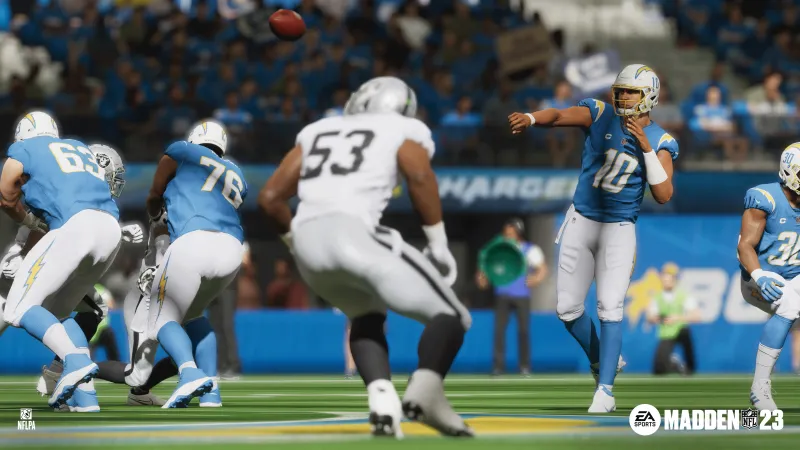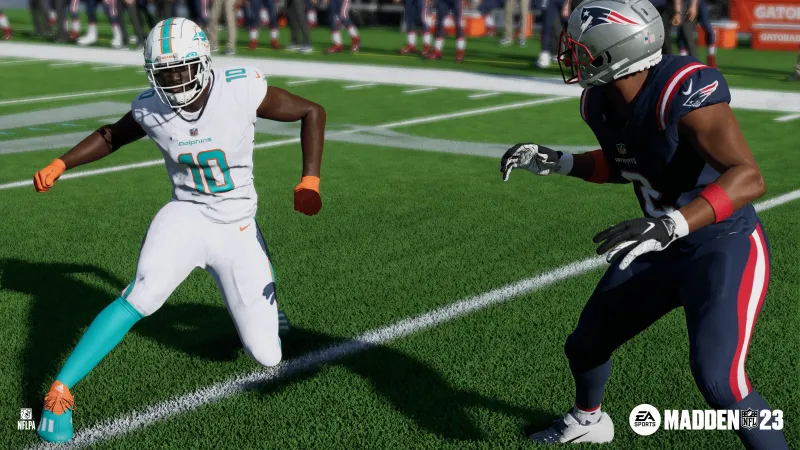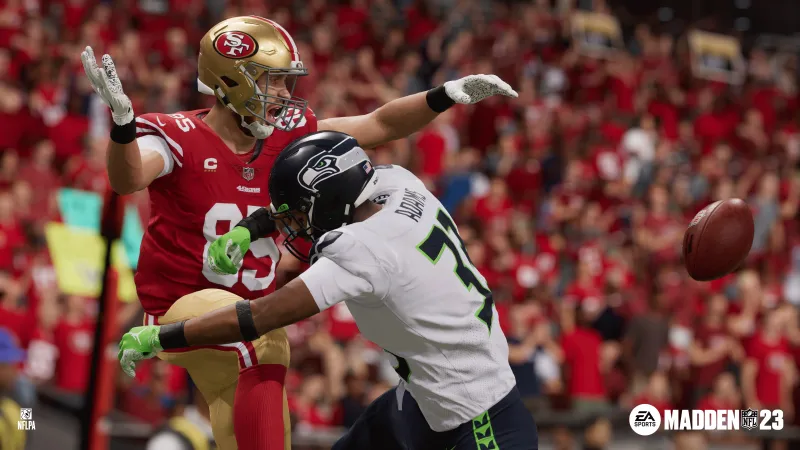
Coming off a down year that felt indicative of the stagnation that so many longtime players decry when looking at the Madden NFL series, EA Sports has a lot to prove. With this year paying tribute to the late John Madden through three special covers, EA Sports wants to deliver a product worthy of putting his face back on the main cover for the first time in more than 20 years. I spent a day in EA Orlando's offices to learn how this year's game pushes the series forward and applies lessons learned from previous years to deliver several key improvements in this year's product.
Diving In
According to the senior producer Mike Mahar, the team looked at reviews, tweets, Reddit posts, and more to see what it needed to focus on before jumping into development on Madden NFL 23. "One approach we took this year that is slightly different than what we did year over year is we took a pretty big pause after launching Madden 22," Mahar said in a presentation to journalists and content creators on hand at the studio. "We mined every source of feedback we could for common and consistent feedback and challenges or just flat-out issues consumers were having with the game, whether they be stability or that thing in the simulation engine in core franchise that people just didn't like year over year. While I can't sit here and say unequivocally that we've fixed every single issue, I can say unequivocally we've addressed hundreds of issues in pre-production, and we added hundreds more during production that we addressed."
While those fixes aren't going to make any back-of-box feature lists, the change in the team's approach is notable for the studio's acknowledgment that something wasn't working. Madden NFL 22 and 21 hold the two lowest Metacritic aggregate review scores in mainline series history, so new content and features could feel hollow if EA Sports didn't first sure up some of the various problems that led to the less-than-stellar launch states of those two games. However, that doesn't mean EA Sports isn't implementing multiple changes in hopes of making Madden NFL 23 transcend the criticism of the game feeling like "just a roster update."

A New Sense of Gameplay
The most significant new feature in Madden NFL 23 is FieldSense, a PS5 and Xbox Series X/S-exclusive gameplay system that gives players more control over their on-the-field team. This mechanic is mainly meant to address the widespread criticism that the gameplay is too rooted in predetermined animations, but it also adds various other benefits. FieldSense affects both sides of the ball and gives you better control of whatever player you're controlling.
On defense, physics dictate how tackles play out instead of predetermined animations. Defenders can join tackles midway through and influence the momentum of the ball carrier and the tackle in progress, which ultimately determines how the animations branch together, informed by physics. The development team has added more than 3,500 new animations for this feature alone to support this. Ball carriers can also get stood up during the tackling process, resulting in a brief button-mashing sequence (can be toggled to pressing for accessibility). The result of these stand-up tackles can range from the running back breaking through or the carrier being held up long enough to be stripped of the ball. But what about while the ball is in the air? Defensive backs can now knock the ball out of the receivers' hands in mid-air (rather than waiting for the drop to occur when the receiver comes back to the ground), and defenders can push receivers out of bounds.
To counteract the new abilities tacklers have through FieldSense, the gameplay system offers ball carriers new 360° cuts. This new system lets players hold the left trigger and perform sharp cuts with their ball carrier. The right stick still offers moves like jukes, but the 360° cuts system lets you turn sharply during a run, as opposed to the smooth arc a running back needs to make when pushing through a crowded line of scrimmage.

Finally, when you're under center as the quarterback, FieldSense puts a new skill-based passing mechanic at your disposal. This new system lets you thread the needle to deliver the pass exactly where you want it. When you drop back to pass and press the button that corresponds with the receiver you wish to target, a small circle will appear on the field with a targeting reticle. Using the stick, you can choose exactly where you want to place the ball within ;the targeting circle, where the receiver is guaranteed to have a chance to catch the ball. If you hold the left trigger while placing your pass, you can cause the targeting reticle to leave the circle. This mechanic lets you gamble on the accuracy of your throw and your receiver's ability for the potential of a pass that isn't remotely defendable by the players on the other side of the ball. Quarterbacks also receive a new passing meter that lets you control the power and trajectory of your throws by timing the meter correctly. To allow you more precision for placing the football, you can set a special slowdown effect for when you're playing locally, but when you go online, the slowdown for skill-based passing is disabled.
During my hands-on time, these improvements brought on by FieldSense were immediately noticeable. On offense, the difference in how a ball carrier cuts while holding down the trigger versus how they control traditionally (now, when you don't hold down the trigger) is night and day. Running up the middle with my running back afforded me more control over how I could cut through the lanes presented by my blockers, while putting the ball in the hands of Lamar Jackson let me mess around with both the skill-based passing and the 360° cuts mechanics. During my time with the game, I tried to test out the limits of the skill-based passing; I pulled the left trigger to allow me to move the reticle outside of the targeting area, aimed further downfield and threw a high lob pass with the hopes of giving my receiver enough time to get under it. While I overshot the receiver a couple of times, I was also able to connect with my teammate for a touchdown.
FieldSense may be in its first year with Madden NFL 23, but it seems to add a lot to the core experience of playing a football game. If this year's iteration can deliver on the team's hopes, this could put the Madden series back on track. However, EA Sports and EA Tiburon aren't stopping there, as they're introducing myriad other improvements and features to give players a better overall experience.
Back to Basics
As indicated by EA Tiburon's approach to gathering feedback, the studio knows how much you don't like playing against running quarterbacks. While the team knows there's no magic wand to wave to solve the mobile QB problem on defense (one team member even joked about how if they had that answer, they'd probably be coaching in the NFL), the studio has made significant strides towards this and other ways in which gameplay progresses throughout a game.
Starting with the mobile QB problem, Madden NFL 23 introduces substantially better QB contain logic. Defensive players take more intelligent paths to quarterbacks and prevent you from rolling out as easily as you could in previous Madden games. In fact, in my hands-on time, I barely ever made it past the pass rushers to rollout for an out-of-pocket pass as Lamar Jackson, and my scrambles often forced me up the middle, sometimes resulting in a bigger hit and a fumble. Topping those new pass rush enhancements, the dreaded Escape Artist ability, which makes a QB faster out of the pocket, has not only been tuned down from its borderline broken state in Madden NFL 22 but also turned into an X-Factor for less frequent use. Madden NFL 23 also tweaks how coverage in the secondary works, resulting in more swats, more hits, and fewer interceptions.
Finally, EA Sports brought in an NFL coach (who asked to remain anonymous) to consult with the team about what could be improved. One of the key takeaways was that the playbooks have too many plays for someone who isn't a football aficionado. So EA looked at the player data from the recent games and streamlined the playbooks, removing unpopular or ineffective plays and adding more team-specific plays. The result, according to EA, is a better play-selection process and more polished gameplay since the team has fewer plays to worry about.
